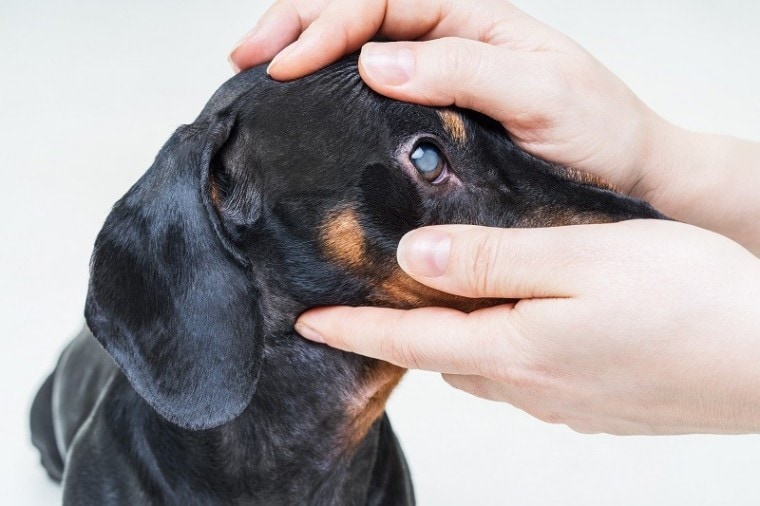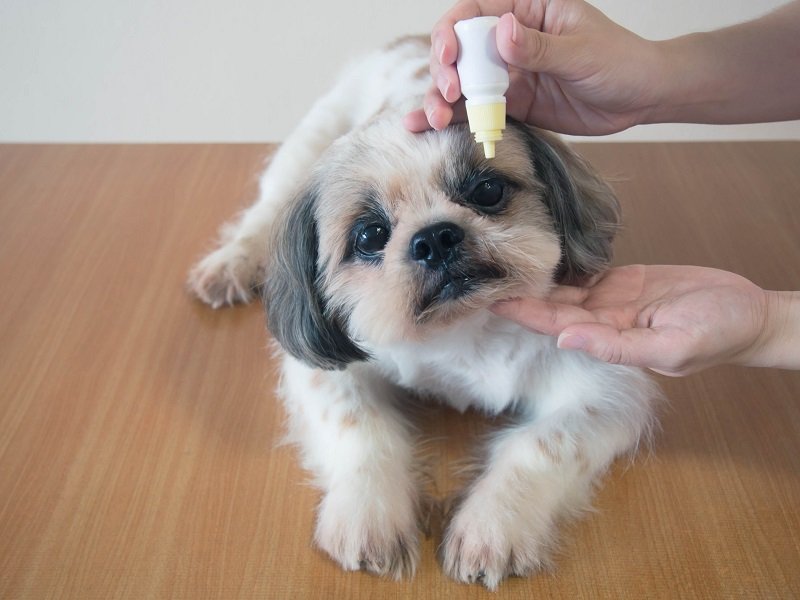
Cataracts in dogs are when one or both lenses in the eye cloud. These changes occur from a change in the structure of the lens. When this cloudiness takes over, light can’t reach the dog’s retina, causing poor vision or even blindness. After they mature, cataracts look like a white disk that sits behind the dog’s iris. The once-black eyes eventually look gray or white.
Many people confuse cataracts with nuclear or lenticular sclerosis. This eye condition is not the same as cataracts. Nuclear sclerosis is caused by the hardening of the lens that happens naturally with age. It is a benign process. The light is still able to pass through the retina so that they can see, but their eyes do tend to develop a bluish haze that looks similar to cataracts.
How do you diagnose cataracts, and what can your vet do to treat them? Use this valuable article to help you understand why your dog has cataracts and how they are going to affect their life from now on.
Causes of Dog Cataracts
Cataracts in dogs are usually genetic or hereditary, although they don’t have to be. Different gene mutations that cause cataracts have been identified in dogs. Cataracts associated with the HSF4 gene affect the dog’s vision bilaterally and in the posterior areas of the lens. They usually start out very small and progressively grow.
More than 50 dog breeds are confirmed to have issues with hereditary cataracts. If your dog carries the gene mutation, its chance of getting this condition increases. There is genetic testing available if you are curious about whether your dog may get them, but remember that not every dog with the mutations will definitely have cataracts, just like how some dogs without the mutation will.
Another common cause of canine cataracts is diabetes. In diabetic dogs, 50% develop cataracts within 6 months of their diagnosis, 75% develop them within a year, and 80% develop them within 16 months. High blood sugar levels jumpstart the imbalance of water in the lens and encourage the cataracts to form. This condition forms a lot more quickly in diabetic dogs, and some could lose their vision in a matter of days.

How Vets Diagnose Cataracts
So, you suspect that your dog has cataracts. Now how is your vet going to diagnose it? Veterinarians perform a few tests to come up with a diagnosis. First, they give your dog a thorough physical check and examine your dog’s eyes with special equipment. Second, they do some blood tests to see if there are any underlying conditions that could have caused it. They use this information, to determine the cause of your dog’s cataracts, if possible.
How to Treat Dogs with Cataracts
Unfortunately, as of right now, there isn’t an eye drop or medication that reverses the presence or the progression of cataracts. We know how much you care for and love your pets and want them to live a healthy life, so there are some options if you and your vet think it is the right choice.
You have to take your dog to a veterinary ophthalmologist so that they can determine if your pet is a possible candidate for cataract surgery. Keep in mind that the veterinary ophthalmologist may recommend some tests before deciding if your dog is a good candidate for cataract surgery. During cataract surgery, your veterinary ophthalmologist will remove the cloudy lens and will likely implant an intraocular lens (IOL) to restore your dog’s vision completely. Once an eye has been operated on, cataracts won’t come back.
Dogs with other illnesses, on top of their cataracts, like diabetes and kidney and heart-disease, are also higher-risk patients in terms of their anesthesia and post-op care requirements. If your dog has other eye conditions associated with their cataracts, your vet may prescribe eye drops to help control the inflammation or the pressure inside the eye. There are also some over-the-counter eye drops that you can get to help your dog keep their eyes lubricated and free of debris.

How to Tell if Your Dog is Developing Cataracts
Remember how we said that our dog’s eyes aren’t that different from ours? Well, just like us, a dog’s eyes change as they get older. The first sign that your dog could have cataracts is if they are aging, and you start to notice cloudy blue, gray, or white coloring in their eyes. Keep a close eye– no pun intended– on them and look for any changes over the following days or weeks. They may stay the same size or grow, so the safest option is to take them to the vet. Also, cataracts can be congenital (present at birth) or happen as a result of trauma. It is therefore important to observe your dog’s eyes at all ages and times and be vigilant for any cloudiness.
What Happens to Untreated Cataracts?
To put it simply, cataracts left untreated in your dogs cause them to go blind. The sooner you’re able to catch them, the better chances they have at being a good candidate for surgery.
Cataracts completely block the light from entering the eye, and soon, your dog won’t be able to see at all. If left completely untreated, your dog’s eyes can suffer serious consequences such as uveitis, glaucoma, and lens luxation.
Glaucoma is another eye condition where there is increased pressure on the eye, so much that it damages the optic nerve. Once this nerve is damaged, the blindness is permanent. Not all cataracts lead to glaucoma and blindness, and some dogs still have some sight for the remainder of their lives.
Glaucoma isn’t the only risk from leaving cataracts untreated. Lens luxation is another possible result. This is a condition that allows the lens to float out of place and cause even more eye and vision issues.

Breeds Prone to Cataracts
Always do in-depth research before adopting a new dog. Some breeds are more susceptible to cataracts than others, and it is something to consider before you make that commitment. Here is a list of known dog breeds with a high risk of cataracts:
Preventing Cataracts
As much as we hate to say it, there isn’t much you can do to prevent cataracts from happening. Suppose you want to catch it as early as possible so that you have treatment options. In that case, the best step you can take is to examine your pet’s eyes regularly, take them to the vet’s office if you notice anything unusual, find the medical history of your pet’s parents if possible.
Conclusion
We love our furry companions and would do almost anything to take away their suffering. Although cataracts aren’t considered painful, they have a huge impact on your dog’s life and how they experience the world around them. It is important to know that the earlier cataracts are detected, the greater the chance of successful surgery. Do your best to get your dog to routine health checks, especially as they age. You may suspect nuclear sclerosis rather than cataracts, but only your veterinarian can distinguish between the two and make a plan accordingly. If vision loss occurs and your dog cannot be operated on or is awaiting surgery, get used to their new lifestyle and make life easier for them in any way that you can.
Featured Image Credit: Masarik, Shutterstock








